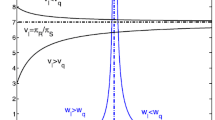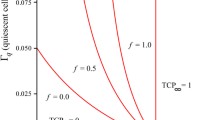Abstract
For the tumor model of Skipper and Zubrod, which has been analyzed previously for the theoretical FLM function and the effect of chemotherapy against tumors of known or assumed kinetic characteristics, the theoretical continuous labeling (CL) function is derived by considering an equivalent tumor (in terms of unlabeled cell populations) in which the density function of phase duration of cells inS-phasef 2(a 2)=δ(a 2−∞) and the loss functionL 2(t)=0. This mathematical concept of blocking is applied to the analysis of synchronization in tumor growth and blocking effects in cancer chemotherapy. These effects of chemical agents on the cell cycle progression are being incorporated into a previously written computer simulation program for cancer chemotherapy. Whereas, a program is written and used to simulate the CL functions for L1210 leukemia, and primary and metastatic Lewis lung carcinoma.
Similar content being viewed by others
Literature
Bertalanffy, F. D. and M. H. L. Gibson. 1971. “The In Vivo Effects of Arabinosylcytosine on the Cell Proliferation of Murine B16 Melanoma and Ehrlich Ascites Tumor.”Cancer Res.,31, 66–71.
Brehaut, L. A. and P. H. Fitzgerald. 1968. “The Effects of Cytosine Arabinoside on the Cell Cycle of Cultured Human Leukocytes: A Microdensitometric and Autoradiographic Study.”Cell Tissue Kinetics,1, 147–152.
Chuang, S. N. 1975a.A User’s Manual for Computer Simulation of Cancer Chemotherapy.
— 1975b. “Mathematical Models for Cancer Chemotherapy: Pharmacokinetic and Cell Kinetic Considerations.”Cancer Chemother. Rep., Part 1,59, 827–842.
Chuang, S. N. 1976. “Computer Simulation of Tumor Growth and Response to Chemotherapy for L1210 Leukemia and Lewis Lung Carcinoma,” in manuscript.
— and H. H. Lloyd. 1975. “Mathematical Analysis of Cancer Chemotherapy.”Bull. Math. Biol.,37, 147–160.
Cooley, J. W. and J. S. Tukey. 1965. “An Algorithm for the Machine Calculation of Complex Fourier Series.”Math. Comput.,19, 297–301.
Graham, F. L. and G. F. Whitmore. 1970. “The Effect of 1-β-d-Arabinofurnosylcytosine on Growth, Viability and DNA Synthesis of Mousel-cells.”Cancer Res.,30, 2627–2635.
Hartmann, N. R. and T. Pedersen. 1970. “Analysis of the Kinetics of Granulosa Cell Populations in the Mouse Ovary.”Cell and Tissue Kinetics,3, 1–11.
Karon, M. and S. Shirakawa. 1969. “The Locus of Action of 1-β-d-arabinofurnosylcytosine in the Cell cycle.”Cancer Res.,27, 687–696.
Kim, S. H. and M. L. Eidinoff. 1965. “Action of 1-β-d-arabinofurnosylcytosine on the Nucleic Acid, Metabolism and Viability of Hela Cells.”Cancer Res.,25, 698–702.
Lampkin, B. C., T. Nagao and A. M. Maurer. 1969. “Synchronization of the Mitotic Cycle in Acute Leukemia.”Nature (Lond.),222, 1274–1275.
MacDonald, P. D. M. 1970. “Statistical Inference from the Fraction Labelled Mitoses Curve.”Biometrika,57, 489–503.
Pedersen, T. and N. R. Hartmann. 1971. “The Kinetics of Granulosa Cells in Developing Follicles in the Mouse Ovary.”Cell and Tissue Kinetics,4, 171–184.
Simpson-Herren, L., A. H. Samford and J. P. Holmquist. 1974. “Cell Population Kinetics of Transplanted and Metastatic Lewis Lung Carcinoma.”Cell and Tissue Kinetics,7, 349–361.
———, T. A. Springer and H. H. Lloyd. 1976. “Ambiguity of the Thymidine Index.”Cancer Res.,36, 4705–4709.
Skipper, H. E. 1969. “Improvement of the Model Systems.”Cancer Res.,29, 2329–2333.
Steel, G. G., K. Adams and J. C. Barrett. 1966. “Analysis of the Cell Population Kinetics of Transplanted Tumors of Widely-Differing Growth Rate.”Br. J. Cancer,20, 784–800.
Tobey, R. A. 1972. “Effects of Cytosine Arabinoside, Daunomycin, Mithramycin, Azacytidine and Camptothecin on Mammalian Cell Cycle Traverse.”Cancer Res.,32, 2720–2725.
Tobey, R. A. and K. D. Ley. 1971. “Isoleucine-Mediated Regulation of Genome Replication in Various Mammalian Cell Lives.”Cancer Res.,31, 46–51.
Van Forester, H. 1959. “Some Remarks on Changing Populations.” InThe Kinetics of Cellular Proliferation, Ed. F. Stohlman, Jr., pp. 382–407. New York: Grune & Stratton.
Woo, K. B., L. B. Brenkus and K. M. Wiig. 1975. “Analysis of the Effects of Antitumor Drugs on Cell Cycle Kinetics.”Cancer Chemother. Rep., Part 1,59, 847–860.
Author information
Authors and Affiliations
Rights and permissions
About this article
Cite this article
Chuang, SN., Soong, T.T. Mathematical analysis of cancer chemotherapy: The effects of chemotherapeutic agents on the cell cycle traverse. Bltn Mathcal Biology 40, 499–512 (1978). https://doi.org/10.1007/BF02460774
Received:
Revised:
Issue Date:
DOI: https://doi.org/10.1007/BF02460774




